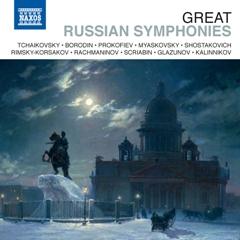Great Russian Symphonies - Vol. 10 (2012)
Great Russian Symphonies - Vol. 10 (2012)

Glazunov, Alexander Konstantinovich Symphony No. 6 in C Minor, Op. 58 1. I. Adagio - Allegro appassionato 00:11:05 2. II. Theme and Variations 00:11:04 3. III. Intermezzo: Allegretto 00:04:53 4. IV. Finale: Andante maestoso - Moderato maestoso - Scherzando - Allegro pesante - Allegro moderato 00:11:03 Kalinnikov, Vasily Sergeyevich Symphony No. 1 in G Minor 5. I. Allegro moderato 00:14:18 6. II. Andante commodamente 00:07:12 7. III. Scherzo: Allegro non troppo - moderato assai 00:08:14 8. IV. Finale: Allegro moderato 00:09:16 Moscow Symphony Orchestra Alexander Anissimov - conductor (1 - 4) National Symphony Orchestra of Ukraine Theodore Kuchar - conductor (5 - 8)
While the Symphony No. 6 in C minor, Op. 58, of 1896 by Alexander Glazunov is not the most personally characteristic of his eight completed symphonies -- the optimistic Third or the Olympian Fifth are more typical of his confident symphonic aesthetic -- it is arguably the most typically Russian of his symphonies. Part of the reason for this is the scoring -- violins in octaves above massed brass at its climaxes à la Tchaikovsky and gorgeously colorful woodwind writing in its central movements -- part of it is the themes -- ardent and powerful with a yearning quality characteristic of fin de siècle Russian symphonies -- but most of it is the furious tone of the opening movement. With the darkly unfolding Adagio leading into a Allegro appassionato that balances a passionately despairing first theme with a fervently supplicating second theme, Glazunov's Sixth sounds like a Russian symphony composed after the death of Tchaikovsky. But the Sixth is more than the work of a symphonic epigone. While the tone of the opening movement sounds typically Russian, its chromatic melodic and cogent harmonic structure makes it sound much more modern than contemporary symphonies by Kalinnikov or even Rachmaninov. Even more modern are the Sixth's second and fourth movements. The second movement is a theme and seven variations that slowly transmutes the tone of the symphony from the fury of the opening movement to one of calm acceptance. The brief third-movement Intermezzo that precedes the Finale is lighter in tone than anything else in the symphony. The Finale itself is one of Glazunov's most successful closing movements. With its magisterial Andante maestoso introduction announcing the chorale theme that will ultimately cap the movement, its highly contrasted themes -- the first confidently striding in the winds Moderato maestoso, the second a lilting Scherzando theme for the flutes, horns, and strings -- the Finale seems at first too episodic to cohere. Glazunov's superb technical skills, however, form all the Finale's material into an organic whole and the tone of the Finale -- powerfully positive -- is altogether Glazunov's own. ---James Leonard, allmusic.com
In 1893 Kalinnikov was appointed to his first important musical post, as second conductor of the Italian Opera in Moscow. Not many months before he had also been given a post, on the recommendation of Pyotr Tchaikovsky, as conductor of the Malïy Theatre in the same city. His career seemed set to take off, but ongoing health problems, including tuberculosis, forced Kalinnikov to resign those posts within months of having received them. By 1894, Kalinnikov was settled in the warmer climate of Yalta, in the South Crimea, where he lived until his premature death in 1901. It was at Yalta that Kalinnikov wrote some of his most popular works, including the biggest success of his career, the Symphony No. 1, written over the years 1894 and 1895. The symphony, dedicated to Kalinnikov's teacher S.N. Kruglikov, was given its premiere in Kiev at a Russian Music Society concert conducted by Vinogradsky. The audience loved the work, requesting and receiving repeat performances of the work's two middle movements. Further successful performances followed soon all over Europe, including Vienna, Paris, London, and Berlin.
The reception the work enjoyed is not hard to understand. Kalinnikov loads his symphony with memorable melodies, he develops them with great skill, and his fluent and colorful orchestration calls Tchaikovsky to mind. The arresting theme with which the work opens is evocative of Russian folk song. Later in the Allegro moderato first movement, a broad second theme emerges in the strings, with decorations provided by the woodwinds. The fluently contrapuntal development section reminds the listener that Kalinnikov had practiced polyphonic writing in a series of fugues composed in the 1880s. The lyrical and melancholy second movement, Andante commodamente, is highlighted by a rich main theme in the oboe over pizzicato strings. Russian folk song is once again called to mind in the swaggering theme of the Scherzo third movement; the more restrained middle section featuring another folksy melody over a drone. The rousing Finale comes complete with reminders of some of the themes heard earlier in the work; the extroverted main theme interacts with some of those earlier tunes, leading to a powerful and triumphant conclusion. ---Chris Morrison, allmusic.com
download (mp3 @320 kbs):








